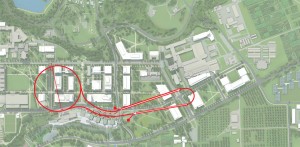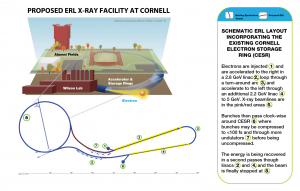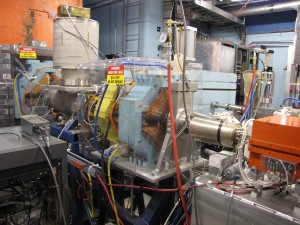The idea behind recycling is straightforward: reuse what you have to make more of the same.
Applying this concept, however, is seldom simple. In the case of Cornell University’s Energy Recovery Linac (ERL), recycling energy to generate particle beams requires technological advancements that are born from decades of research. If scientists there fulfil their mission, they’ll be able to use particle beams to accelerate particle beams, producing some of the brightest bunches to be made by an accelerator.
“It’s a new technique that hasn’t been used to produce brilliant x-ray beams anywhere before,” said Georg Hoffstaetter, associate chair of Cornell Laboratory for Accelerator-based Sciences and Education (CLASSE) for the ERL accelerator. “Such things don’t come around so often. It’s an exciting project to work on.”

Cornell's Energy Recovery Linac will lie under the Cornell campus. The Cornell Electron Storage Ring, known as CESR, will be incorporated as part of the ERL. Image provided courtesy of Bruce Dunham.
The aim is to produce high-brightness, focused light beams with short pulses. Linear accelerators, or linacs, are good at this, much more so than circular accelerators. Jefferson Lab in Virginia, for example, has an ERL-based free-electron laser that generates infrared and ultraviolet light for its users, using 135-megaelectronvolt electron beams to generate the light.
However, to produce X-rays, much higher energies are needed. Cornell scientists are aiming for five-gigaelectronvolt electron-beam energy, which would then generate the linac-quality X-rays. High-brightness beams also require boatloads of current, resulting in a beam power of about half a gigawatt of power.
“That’s almost a nuclear power plant’s worth of electricity required to run it, if one would not use Energy Recovery” said ERL Project Director Bruce Dunham. Since that isn’t the kind of electricity you can just draw out of the wall socket, the team decided to corral energy that was already at hand – the energy from the electron beam as it races through the linac.
“You don’t throw any energy away,” said Dunham.
The electric field in the linac rises and falls many times per second, like the waves of a plucked guitar string. In the energy recovery scheme, an initial electron bunch rides the wave as it’s on the rise, accelerating through superconducting cavities and accumulating energy as it zips its way around the ERL. As the bunch completes its journey, its exit is precisely timed to land on the falling side of the wave, slowing down as it departs from the linac. As it decelerates, it relinquishes its hard-earned energy to the cavities, where it’s stored for the next electron bunch. That bunch will swing by to pick up the cavity’s stored energy a fraction of a nanosecond after the first.
In this way each electron bunch passes its energy to the next like a baton in a relay race. The energy recovery process is over 99% efficient, so the linac would be sufficiently powered and the X-rays that come out of these accelerated bunches would be coherent and bright.
In 2005, the National Science Foundation awarded the ERL Group $18 million to develop a prototype injector for the machine. Last year the group completed construction of the injector, a device that gets the electrons going through the linac. Now in the pre-construction phase, the team is continuing its programme for producing bright beams, testing the cavities that accelerate the beams, building a cryomodule to keep cavities cold, and building a facility to test cathodes, from which the electrons originate.
Maury Tigner, now director of CLASSE, published a paper on the idea of energy recovery in 1965. But the superconducting technology needed to pull it off wasn’t around.
“The ERL was always an interesting curiosity that some people have played with,” said Hoffstaetter. Only in the 1990s, with progress from the TESLA project, could the concept be implemented. Now the Cornell team intends to get as much as they can out of it.
In the last year, the ERL team has made several advancements in instrumentation to get the most use out of their electrons. Their electron gun could be the highest average-power DC photocathode gun ever built. They’ve also developed absorbers for superconducting cavities that soak up power of unwanted frequencies that arise as a result of the ERL’s high beam current. Both developments mean less waste and more useful beam for the ERL.
Cornell is drafting another proposal of the full machine, which will incorporate Wilson Laboratory on the Cornell campus and replace the existing storage ring based in the Cornell High Energy Synchrotron Source X-ray facility. The proposal will address considerations of the tunnel and buildings to house the machine and X-ray beamlines, as well technical considerations of all aspects of the machine.
It could be that in a few years’ time, Cornell’s ERL will provide brilliant
X-rays for use in the biological, medical and material sciences, as well as other fields of science and engineering.
Stay tuned to future issues of NewsLine to read more about accelerator research coming out of Cornell University.



Recent Comments